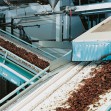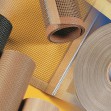Polyurethane belts are one of the most popular types of conveyor belts. The main material used for manufacturing is high-quality polyurethane (PU), which has high wear resistance, hydrophobicity, strength, and durability. Polyurethane is resistant to the effects of lacquers/paints, solvents, fungal and mold growth, mechanical wear (abrasion-resistant), organic compounds (oil, diesel), and can withstand short-term temperature exposure of up to 120°C, temperature and humidity fluctuations without deformation or damage. Such material resistance expands the range of its use in various technological processes, conveyors of different configurations and types.
Various surface structures of polyurethane belts provide additional operational properties, such as wear resistance, elasticity, noise level, static and dynamic strength, durability of the coating, hydrophobicity, corrosion resistance, strength of the tensioned joint, friction coefficient, statics, and visual component (color, type of structure, gloss, etc.).
Thanks to the excellent combination of properties, polyurethane belts are easily cleaned, do not delaminate, provide precise product positioning, and can be used in industries where compliance with FDA and HACCP standards is critical (food, tobacco, etc.).
Compared to PVC belts, polyurethane conveyor belts have higher chemical resistance, thermal stability, lower elongation percentage, and are resistant to cuts and mechanical damage.
Polyurethane conveyor belts can be classified by their area of application in different industries:
- Food industry: Polyurethane belts are used in confectionery, baking, dough preparation, meat and fish processing, vegetable and fruit processing, dairy products, and more. This is the most demanding application for PU belts, as they must comply with high standards such as EU, FDA, and HACCP. Polyurethane belts used in the food industry are hydrophobic, wear-resistant, chemically resistant, resistant to temperature and humidity fluctuations, and relatively lightweight and thin, which allows them to be used on minimal diameter rolls and knife turns.
- Wood industry: Polyurethane belts are used in wood processing and treatment processes such as chipping, transportation, loading, unloading, shaping, drying, laminating, painting, gluing, pressing, etc. Polyurethane belts used in the wood industry are wear-resistant, strong with minimal stretch percentages, which allows them to withstand pressing and high-speed operating modes, resistant to deformation and diagonal distortion under excessive loads. For the wood industry, belts with aramid fabric are often used, which makes them extremely durable.
- Logistics industry: Logistics is one of the most widespread transportation industries, so the range of applications is quite wide: logistics centers, sorting centers, post offices, airport logistics, etc. Polyurethane belts for transportation are used for horizontal and vertical movement of goods, joining, transition (steps), accumulation, acceleration, sorting, and direction. Belts in this logistics industry withstand extreme operating conditions, and therefore have a wide range of surfaces, both as driving and upper layers, which allows for accurate positioning, creating a certain resistance or, on the contrary, facilitating sliding.
- Tobacco industry: In the tobacco industry, polyurethane belts are used in the production and processing of tobacco leaves, transportation, sorting, and packaging of cigarettes. PU belts in this industry are wear-resistant, resistant to tobacco dust, chemicals, temperature, and humidity changes, and are easy to clean.
You may also be interested in: complex solutions, belts splicing, PVC tapes, special tapes, woven conveyor belts, teflon conveyor belts.












